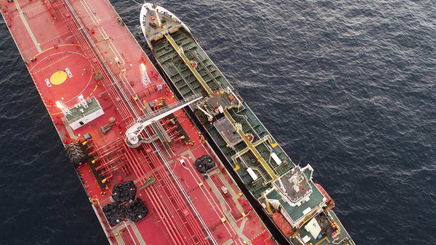In the movie “Spinal Tap,” guitarist Nigel Tufnel shows off an amp with a dial that goes from zero to 11. “It’s one louder,” he boasts. When asked why the amp strength for 10 is not simply increased, he replies, “These go to 11.”
In ocean shipping, the dial can swing in the opposite direction. Reported freight rates are sometimes below zero. Is this just a measurement mirage, à la Tufnel’s amp? Or do rates actually go negative, with shipowners effectively paying to move someone else’s cargo?
Negative TCE rates
Last week, average time-charter equivalent (TCE) rates for very large crude carriers (VLCCs; tankers that carry 2 million barrels of crude) sank to -$7,400 per day on the Middle East-Asia route. Multiplied by a voyage duration of around 50 days, that’s a net cost of $370,000 to the shipowner delivering a customer’s crude.
Clarksons Platou Securities said the current downturn marked “the lowest VLCC earnings in probably 25 years.”
Dry bulk shipping saw negative rates in Q1 2020. Average TCE rates for Capesizes, bulkers with capacity of around 180,000 deadweight tons, briefly dipped to -$98 per day on the Australia-China route.
TCE rate calculation
Negative rates are not about a shipowner telling an oil trader, “Hey, if you give me this job, I’ll pay you $370,000 for the privilege of bringing your 2 million barrels of crude from Saudi Arabia to China.”
In a spot voyage deal, the shipper pays the vessel operator per ton of cargo. That, of course, is always a positive number. To derive the TCE rate, the dollars-per-ton price is converted to an estimated dollars-per-day rate, based on assumptions on voyage duration and other factors.
The key point is the ship operator pays for the fuel in a spot voyage contract. So, the TCE rate is calculated net of fuel. Negative TCE rates imply that the ship operator paid more for the voyage’s fuel than it pocketed from the cargo shipper for transport. Which raises the question: Why would a shipowner do such a thing when it will lose less money by refusing the deal?
In many cases, the answer is: The shipowner didn’t.
The problem with rate assumptions
When index providers and brokers estimate TCE rates, they must make assumptions on the price of fuel and average speed of the ship. Reality is different from these estimates.
The fuel price estimate is based on a price in a particular marine bunker fuel hub associated with a particular route on a particular day. But a ship sailing that route did not load its fuel that day. Also, it often loaded fuel under a long-term contract priced below the reported fuel numbers.
More importantly, ship operators doing spot voyage contracts choose what speed they sail on the ballast (unladen) leg. In a depressed market, there’s no reason for the ship operator to rush back to pick up the next load. And the slower the ship returns, the more it saves on fuel.

As Euronav (NYSE: EURN) CEO Hugo De Stoop lamented during a Capital Link virtual event this month, “When we see the average speed computed by some of the brokers — this is a shame. People don’t understand economics. Consumption is exponential. So, if you reduce your speed by 1 or 2 knots, there is a massive reduction of what you’re going to consume.”
In other words, the ship operator may not really be paying more for fuel than it earns on the voyage.
The TCE rate may not really be negative. The fuel assumptions made by the broker or index creator may be too high.
The IMO 2020 factor
Another reason why TCE rates may not really be negative involves the IMO 2020 regulation.

Since Jan. 1, 2020, ships have been required to burn more expensive 0.5% sulfur fuel known as very low sulfur fuel oil (VLSFO). However, if they have exhaust gas scrubbers, they can keep burning cheaper 3.5% sulfur fuel called high-sulfur fuel oil (HSFO).
Because most ships use VLSFO, virtually all TCE indices (except S&P Global Platts’) and broker assessments are calculated by netting out the price of a voyage’s estimated VLSFO consumption. The same dollars-per-ton transaction would equate to a substantially higher TCE rate for a scrubber-equipped ship, because that ship is paying less for its HSFO.
Clarksons estimated earlier this year that 36% of VLCCs and 29% of Capesizes already have scrubbers. Last week, it cited specific examples of scrubber-fitted VLCCs taking very low rates, creating the illusion of negative TCEs.
A side effect of IMO 2020 — a regulation designed to protect the environment — is a lower overall reported rate floor in very depressed tanker and dry bulk markets. Because now, a sizable portion of the fleet (those with scrubbers) can underbid the ships being used to calculate TCE rate assessments (those without scrubbers).
Some negative rates are real
Despite the various illusory effects, some rates are actually negative. There are several reasons ship operators might opt to book a voyage that earns less than the fuel cost.
One is repositioning. A tanker or bulker owner may take a negative-TCE-rate cargo on a backhaul run if it’s repositioning the vessel for a future fronthaul. It may also do so if a ship needs to go a certain direction anyway, such as to a yard for work. If you’re paying for fuel to get somewhere, any money for the cargo is better than nothing.
The debate today is about something different. It’s about whether a ship on a major fronthaul route, such as the Middle East-China VLCC route, would move at a negative TCE rate.
Reluctance to lay up ships
One reason this might conceivably happen is that it’s better to keep ships moving for operational and commercial reasons. Ships that stay stationary too long can suffer from hull fouling (marine growth) and other issues that require maintenance work. That’s why tanker operators use their oldest ships for floating storage charters.
When tankers were flirting with negative TCEs back in 2011, several owners did put ships in layup. The orderbook was much higher then and the recovery was thought to be far off. This year, the orderbook is very low and owners believe the recovery could come as soon as the second half. Fearnleys Research reported last week, “Quiet mutterings of warm [VLCC] layups remain mutterings at present.”
Could owners be reluctant to put tankers into layup in order to avoid both re-start costs and the opportunity cost of being “out of the market” when rates rebound? Could they temporarily accept negative TCE rates due to “FOMO,” the fear of missing out?
The debate continues. Clarksons Platou Securities insisted last week that “negative TCE earnings make no sense of course, as owners would be better off standing still.”
Only shipowners know their own fuel bills, and thus, whether sub-zero TCE rates are actually being accepted. And if they are, shipowners would have no reason to admit it.
It’s worse than it looks
The punchline is that a sub-zero TCE rate is not the real negative number that matters.
For a VLCC, the all-in breakeven rate — including finance costs as well as operating expenses such as crewing — can be around $22,000-$25,000 per day. If a non-scrubber, non-eco-designed VLCC was booked at an actual TCE rate of -$7,400 per day, it could be losing over $32,000 per day. A scrubber-equipped, eco-designed VLCC earning a TCE rate of $2,000 per day could actually be losing $20,000 per day or more.
Negative TCE rates garner headlines. They’re terrible for market sentiment. But the earnings dial for tanker and bulker owners is not really set at zero TCE. The real zero is the breakeven number — and commodity shipping rates sink below that threshold all the time. Click for more FreightWaves/American Shipper articles by Greg Miller
MORE ON TANKER SHIPPING: Full steam ahead for shipping stocks: see story here. OPEC+ deal shocker will prolong crude-tanker bloodletting: see story here. Crude tankers stuck in ‘rate hell’: see story here.

